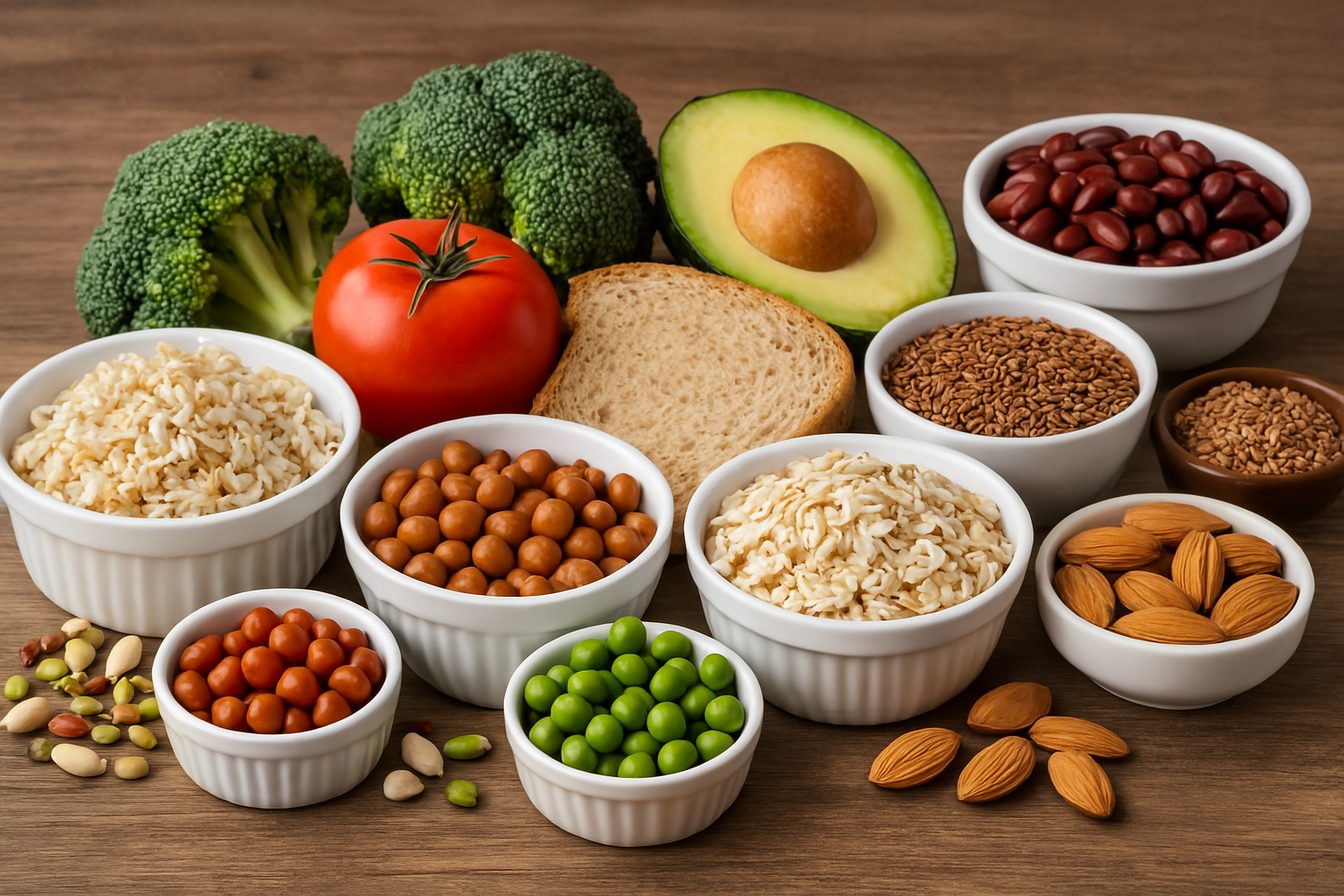Did you know that nearly 75% of adults will experience hemorrhoids at some point in their lives? This common ailment can cause considerable discomfort and impact daily well-being. The good news? A strategic diet, particularly one abundant in high-fiber foods, can significantly alleviate symptoms and prevent future occurrences. If you are battling the inflammation and irritation that accompanies hemorrhoids, this guide will equip you with knowledge about the most effective dietary interventions.
Decoding the Fiber-Hemorrhoid Connection
Fiber, the indigestible portion of plant-based foods, is paramount for digestive health. It adds bulk to your stool, making it softer and easier to pass. This crucial function reduces the strain on your rectum and anus, the very areas affected by hemorrhoids. A high-fiber diet effectively mitigates constipation, a notorious trigger for hemorrhoids, creating a pathway for healing and preventative maintenance.
Building Your Fiber-Focused Arsenal: The Top 14 Foods
Navigating the vast landscape of food choices can be daunting. That is why this curated list pinpoints the 14 most impactful high-fiber foods you should integrate into your daily routine to address and potentially treat hemorrhoids.
1. Beans: These nutritional powerhouses, including kidney beans, black beans, and navy beans, are fiber champions. Half a cup boasts a significant dose, aiding regularity and reducing straining. 2. Lentils: Another legume lending a substantial amount of fiber, alongside vital protein. Their culinary adaptability makes them a fantastic addition to soups, stews, and salads.
3. Broccoli: This cruciferous vegetable provides a respectable fiber contribution, along with antioxidants and vitamins, fostering overall gut health.
4. Brussels Sprouts: Similar to broccoli, Brussels sprouts are brimming with fiber and beneficial compounds. Roasting them enhances their flavor and appeal.
5. Avocados: Not just trendy toast-toppers, avocados deliver healthy fats and fiber. They contribute to smoother bowel movements due to the healthy fats acting as a lubricant. 6. Berries: Strawberries, blueberries, raspberries, and blackberries are naturally sweet treats offering antioxidants and fiber. Snack on them or include them in breakfast bowls for a refreshing boost. 7. Apples: Enjoy this easily accessible fruit for a dose of soluble fiber, especially when consuming the skin. Apples also contain pectin, a prebiotic that nourishes beneficial gut bacteria.
8. Pears: Like apples, pears offer valuable fiber, especially when you leave the skin on. Their soft texture also makes them easy to tolerate for those experiencing discomfort.
9. Prunes: While some shy away due to their laxative reputation, prunes can be incredibly effective at relieving constipation and, in turn, diminishing hemorrhoid symptoms. Remember, moderation is key.
10. Oats: Oatmeal provides a filling and comforting fiber source, readily incorporated into breakfast routines. Opt for steel-cut or rolled oats over instant varieties for maximum benefit.
11. Whole Wheat Bread: Replace processed white bread with whole wheat bread. Ensure the product is genuinely whole wheat, evidenced by the ingredient list, as some breads labeled whole wheat contain negligible amounts of fiber.
12. Quinoa: This ancient grain provides a substantial serving of fiber, along with protein and essential amino acids. It functions well as a rice alternative or salad base.
13. Flaxseeds: Sprinkling ground flaxseeds on cereals, salads, or yogurt is a seamless way to up your fiber intake. They also boast omega-3 fatty acids.
14. Chia Seeds: Similar to flaxseeds, chia seeds swell when exposed to liquid, fostering a feeling of fullness and easing stool passage. Integrate them into smoothies or sprinkle them on meals.
Constructing Your Fiber-Rich Regimen: A Practical Guide
Introducing these foods into your diet requires a methodical approach to prevent unpleasant side effects such as bloating and gas.
1. Start Slowly: Do not radically overhaul your diet overnight. Increase your fiber intake gradually to give your digestive system time to adapt.
2. Hydrate Adequately: Fiber absorbs water, so consuming an ample amount of fluids (water is best) is indispensable. Aim for at least eight glasses daily.
3. Diversify Your Choices: Eating a wide array of high-fiber foods delivers a comprehensive nutrient profile and keeps your meals interesting.
4. Read Labels Meticulously: Pay attention to serving sizes and fiber content per serving when purchasing packaged foods.
Navigating Potential Pitfalls
Despite the evident benefits, there are several potential hurdles to overcome when incorporating more fiber. Awareness is key.
- Bloating and Gas: Rushing into a high-fiber diet without enough water can lead to increased gas and bloating. Patience is your best strategy.
- Mineral Absorption: Very high fiber consumption might interfere with mineral absorption. This is only usually an issue with drastically high intake or existing nutrient deficiencies. Consult with a doctor if concerned.
- Underlying Conditions: Certain digestive conditions may necessitate a tailored approach to fiber intake. Consult with a healthcare professional for personalized guidance.
Tools and Aids for Fiber Success
While a whole-food diet is the primary goal, some tools can aid in your high-fiber journey:
- Fiber Supplements: Psyllium husk and methylcellulose supplements provide concentrated fiber, though they are not a replacement for whole foods.
- Food Diary: Tracking your food intake can shed light on your fiber consumption habits.
- Water Tracking Apps: These applications help you maintain adequate hydration levels.
Tables For High-Fiber Foods
| Food | Serving Size | Fiber Content (grams) | Other Benefits |
|---|---|---|---|
| :————— | :—————— | :——————— | :———————————————— |
| Kidney Beans | 1/2 cup cooked | 11 | Protein, Iron |
| Lentils | 1/2 cup cooked | 8 | Protein, Folate |
| Broccoli | 1 cup cooked | 5 | Vitamin C, Vitamin K |
| Avocados | 1/2 medium | 7 | Healthy Fats, Potassium |
| Raspberries | 1 cup | 8 | Antioxidants, Vitamin C |
| Apples | 1 medium | 4 | Vitamin C, Potassium |
| Oats | 1/2 cup dry | 4 | Beta-glucan, Manganese |
| Whole Wheat Bread | 1 slice | 2-4 | B Vitamins, Selenium |
| Prunes | 5 prunes | 3 | Potassium, Vitamin K |
| Flaxseeds | 1 tablespoon ground | 2 | Omega-3 Fatty Acids, Lignans |
| Chia Seeds | 1 tablespoon | 5 | Omega-3 Fatty Acids, Calcium |
| Quinoa | 1 cup cooked | 5 | Protein, Iron, Magnesium |
| Pears | 1 medium | 6 | Vitamin C, Potassium |
| Brussels Sprouts | 1 cup cooked | 4 | Vitamin C, Vitamin K |
Note: Fiber content can vary slightly depending on the specific variety and preparation method.
Key Takeaways for Hemorrhoid Relief
- Prioritize a gradual increase in fiber intake.
- Adequate hydration is crucial for optimal digestion and preventing adverse effects.
- Diversify your high-fiber food selections to guarantee comprehensive nutrient intake.
- Pay careful attention to potential pitfalls like bloating and mineral absorption interference.
Frequently Asked Questions
Is a high-fiber diet effective for all types of hemorrhoids?
High-fiber foods can help manage and relieve symptoms of both internal and external hemorrhoids by promoting softer stools and reducing straining during bowel movements.
How quickly will dietary changes alleviate discomfort?
The timeline varies based on individual factors and the severity of the condition. Some experience improvement within days, while others need a few weeks to experience noticeable change. Consistency is key.
Are there any foods I should completely avoid with hemorrhoids?
Limit or avoid foods that are highly processed, spicy, or contain caffeine or alcohol. These may irritate the digestive system or cause constipation, worsening symptoms.
Can fiber supplements replace fiber from whole foods?
While supplements provide convenience, they lack other vital nutrients and benefits that come with whole foods. Prioritize obtaining fiber from natural sources for optimal health.
How much fiber should I be aiming for daily?
Most adults should strive for 25-30 grams of fiber per day. Tracking your food intake is a method to ensure that you are meeting the requirement.
Embracing Dietary Changes for Long-Term Wellness
Adopting a high-fiber diet extends far beyond mere hemorrhoid symptom relief. It serves as a cornerstone for long-term digestive health, weight management, and overall vitality. Take proactive charge of your health by integrating these 14 champion foods into your daily eating patterns.
Recommendations
Before embarking on a significant dietary transformation, consulting with a healthcare provider or a registered dietitian is prudent. They can help you personalize your approach and ensure it aligns with your specific medical requirements and health status. Your journey to health, which is improved bowel function and relief from the irritating discomfort of hemorrhoids is within reach! Ready to begin?
Track your fiber intake for one week. Understand where you need to improve and introduce two to three new foods from the list. Leave a comment below sharing your greatest insights and dietary successes. If your condition does not improve, it is always advised to seek out professional medical help and the attention of your family Doctor!

